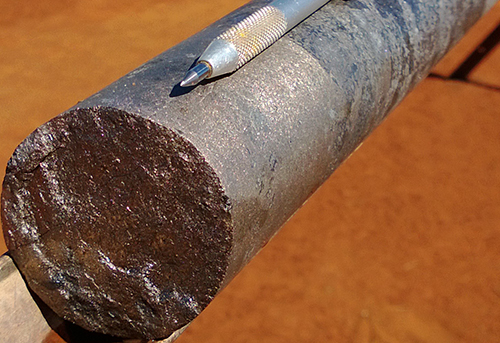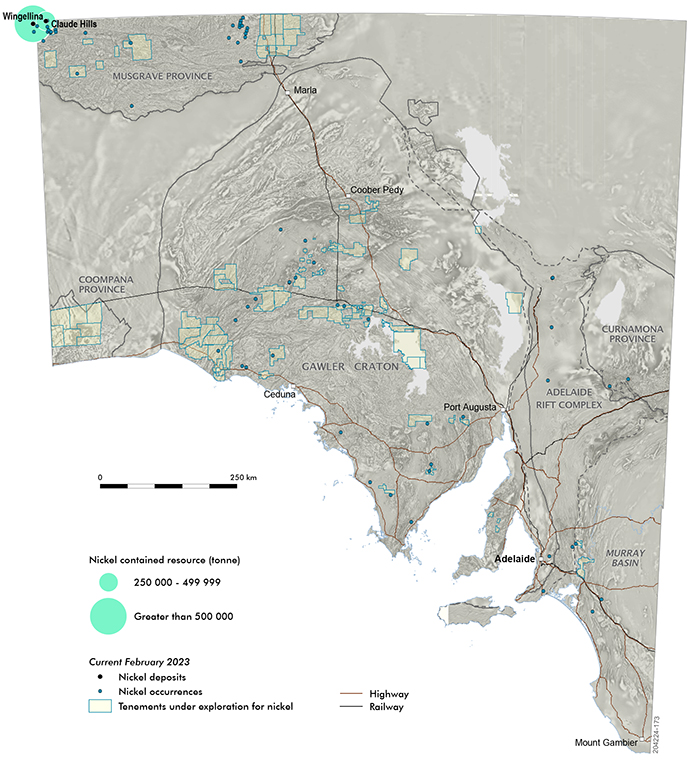Updated February 2023
On this page
Nickel properties and uses
Nickel (Ni) is a hard, silver-white metal with a high melting point which is used in alloys, principally steel, to which it imparts toughness, strength, lightness, anti-corrosion, and electrical and thermal properties. More than 80% of current nickel production is used in metal alloys, predominantly for manufacturing stainless steel. Special alloys with over 50% Ni have been developed for high temperature strength in aircraft jet engines.
Nickel is also an important component of rechargeable batteries, as it allows for higher energy density and greater storage capacity. Due to the growing demand for rechargeable batteries in modern society for smart phones, laptops, electric vehicles and renewable energy storage infrastructure, the demand for nickel is forecast to increase substantially in the coming years.
There are two kinds of commercial nickel deposits: residual concentrations of nickeliferous laterite associated with mafic or ultramafic igneous rocks, and nickel sulphide ores formed by replacement or magmatic injection. About 60% of nickel resources occur as laterite and 40% as sulphides. Pentlandite ((FeNi)9S8) is the primary nickel sulphide ore mineral.
Nickel in South Australia
While there are currently no operating nickel mines in South Australia, multiple companies are currently exploring for nickel across the state, with significant intersections of nickel mineralisation known. These results indicate there are prospective regions for nickel mineralisation in South Australia.
Western Gawler Craton
Both the Fowler Domain and eastern Christie Domain of the western Gawler Craton have significant nickel potential. The Sahara prospect in the western Fowler Domain contains disseminated and massive Ni–Cu sulphides within metagabbro and pyroxenite intrusive bodies (Western Areas 2020). Nickel mineralisation in the region also extends to the Firefly, Meridith, Mystic and Splendour prospects, which are currently the subject of active exploration (IGO Limited 2022). These regions contain mantle-tapping structures, which may provide conduits for mafic intrusions to reach the upper crust where they can form nickel deposits. Several mafic intrusive bodies are also known, demonstrating the additional potential for nickel sulphide mineralisation in these regions.
Musgrave Province
The Musgrave Province that occurs between South Australia, Western Australia and Northern Territory contains layered mafic and ultramafic intrusions of the c. 1090–1040 Ma Giles Complex, which are highly prospective for nickel mineralisation. The Musgrave Province has considerable potential for both primary sulphide, and secondary oxide nickel deposits. Significant sulphide resources have been identified in the Western Australian portion of the Musgrave Block, including the world-class Nebo-Babel deposits (OZ Minerals) with a resource of 390 Mt at 0.31% Ni and 0.34% Cu, and the Wingellina lateritic nickel deposit (NiCo Resources) that contains 182.6 Mt at 0.92% Ni and 0.07% Co. In South Australia there is the Claude Hills lateritic nickel deposit (NiCo Resources) with a resource of 33.3 Mt at 0.81% Ni and 0.07% Co.

Massive sulfide mineralisation, Musgrave Province. (Courtesy Musgrave Minerals)
Coompana Province
The Coompana Province in southwestern South Australia contains largely untested c. 1090–1040 Ma mafic and ultramafic intrusions, equivalent to those of the Musgrave Province. Additional exploration is required to determine the nickel potential of the region.
Harris Greenstone Belt
The Harris Greenstone Belt in the central Gawler Craton contains late-Archaean high-magnesium basalts and komatiitic volcanic rocks that are considered prospective for nickel mineralisation. No significant nickel deposits have been discovered, but anomalous nickel values are reported from Blackfellow Hill, Lake Harris and Aristarchus Rise.



